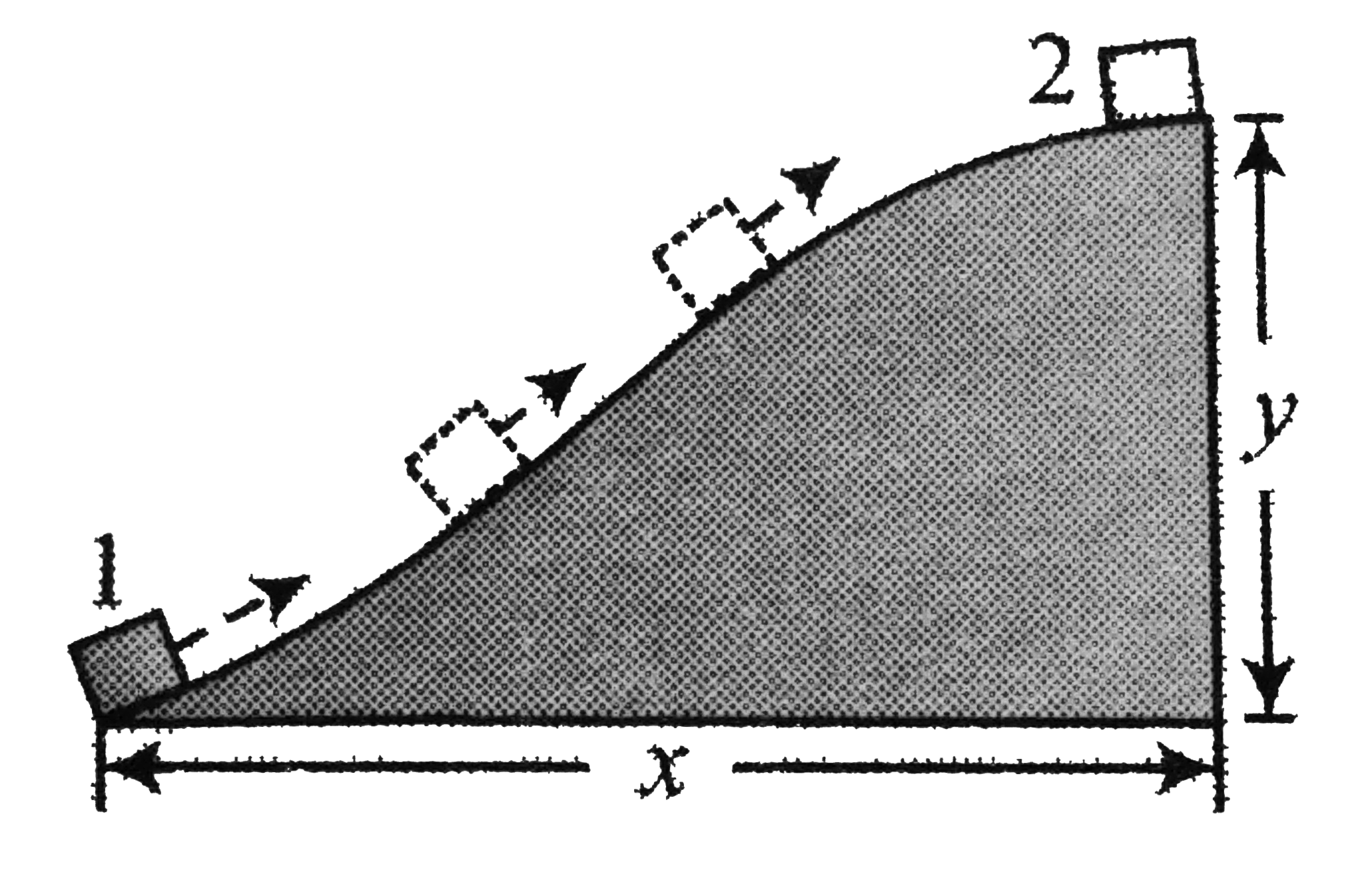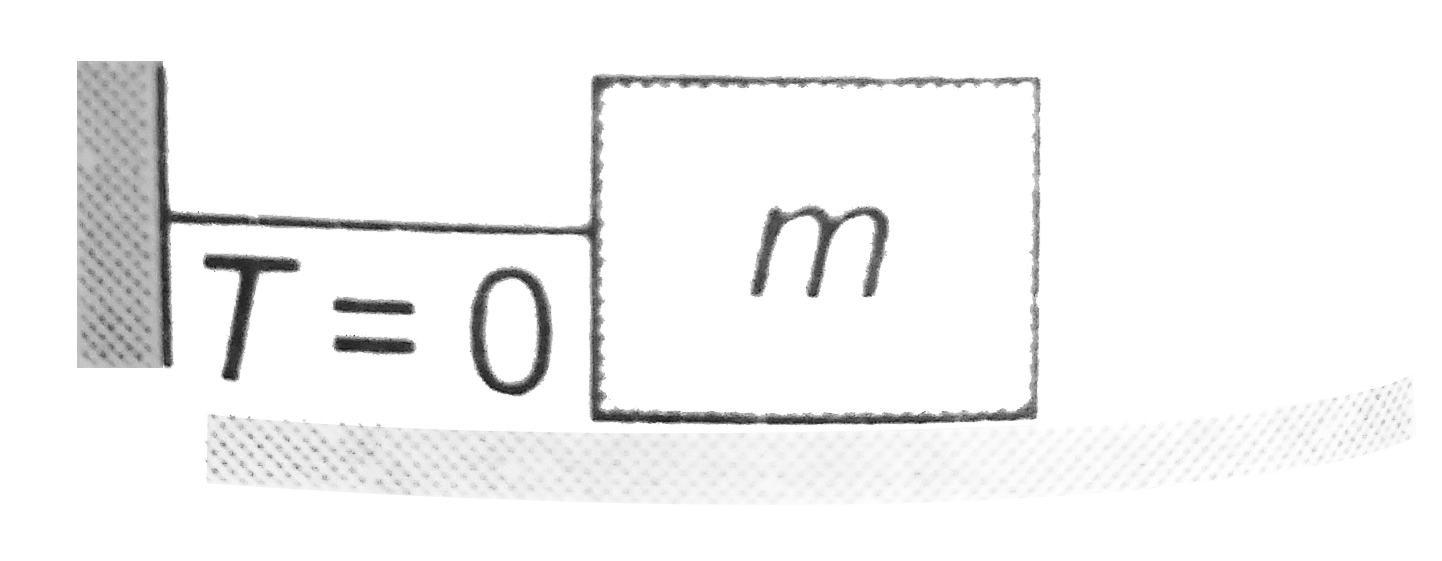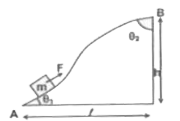A block of mass m is slowly pulled along a curved surface from position 1 and 2. If the coefficient of kinetic friction between the block and surface is μ, find the work done by the applied force.

The forces acting on the block are gravity,
mg↓, N↑, fk↓, and F↑.
Using W-E theorem: W=ΔK

WN+Wgr+WN=Wf=ΔK (i)
For slowly shifting the body,
ΔK=0 (ii)
Work done normal reaction
WN=→N⋅d→s=0 (∴N⊥ds) (iii)
Work done by the gravity
Wgr=−mgy ( ∴ the block moves up) (iv)
Using equations(i), (ii), (iii), and (iv),
WF+Wf=mgy (v)
Wf=∫→fk⋅→ds
=∫fkdscos180∘
=−∫fkds=−∫μNds
=−∫μ(mgcosθ)ds
=−μmg∫dscosθ(dscosθ)=dx)
=−μmg∫x0dx=−μmgx (vi)
Using equations (v) and (vi), WF=mg(μx+y)
Topper's Solved these Questions
- BOOK - CENGAGE PHYSICSCHAPTER - WORK, POWER & ENERGYEXERCISE - Exercise 8.125videos
WORK, POWER & ENERGY
- BOOK - CENGAGE PHYSICSCHAPTER - WORK, POWER & ENERGYEXERCISE - Exercise 8.225videos
WORK, POWER & ENERGY
- BOOK - CENGAGE PHYSICSCHAPTER - WORK, POWER & ENERGYEXERCISE - Archives (integer)4videos
WORK, POWER & ENERGY
- BOOK - CENGAGE PHYSICSCHAPTER - VECTORSEXERCISE - Exercise Multiple Correct5videos
VECTORS
Similar Questions
A horizontal constant force F pulls a block of mass m placed on a horizontal surface. If the coefficient of kinetic friction between the block and ground is μ, find the power delivered by the external agent after a time agent after a time t measured from the beginning of action of the force.
View SolutionA block of mass m is pulled by a constant power P placed on a rough horizontal plane. The coeficient of friction between the block and surface is μ. Find the maximum velocity of the block.
View Solution
Knowledge Check
- Question 1 - Select One
A block of mass M is using on a rough horizontal surface. μR is the coefficient of kinetic friction between the block and the surface. What is the net force exerted by the surface on the block?
AMgBμMgCMg√1+μ2KDMg√1−μ2K - Question 2 - Select One
A block of mass m is stationary on a horizontal surface. It is connected with a string which has no tension. The coefficient of friction between the block and surface is m . Then , the frictional force between the block and surface is:
 AzeroBμmgCμmgμDNone of these
AzeroBμmgCμmgμDNone of these - Question 3 - Select One
A block of mass m is slowly carried on a inclined plane by a force F which always acts along the tangent to the plane. If the co-efficient of friction between the block and incline be μ, then work done by force of friction while carrying block from bottom of the plane to the top will be :
 Adependent on the actual shape of the path between point A and B.Bwill have a total positive valueCwill not change if force F is not applied along the tangent to the plane always.Dindependent of the actual shape of the path between points A and B.
Adependent on the actual shape of the path between point A and B.Bwill have a total positive valueCwill not change if force F is not applied along the tangent to the plane always.Dindependent of the actual shape of the path between points A and B.
A block of mass 5 kg is pulled along a horizontal. The friction coefficient between the block and the surface is 0.5. If the block travels at constant velocity, find the work done by this applied force during a displacement 4 m of the block.
View SolutionA block of mass M is kept on as rough horizontal surface. The coefficient of static frictionbetween the block and the surface is μ. The block is to be pulled by applying a force to it. What minimum force is needed to slide the block? In which direction should this force act?
View SolutionA block of mass 1 kg lies on a horizontal surface in a truck. The coefficient of static friction between the block and the surface is 0.6. If the acceleration of the truck is 5m/s2, the frictional force acting on the block is…………newtons.
View SolutionTwo blocks of Masses M and 2M are connected by a spring of stiffness k .The coefficient of friction between the blocks and the surface is mu Find the minimum constant force F to be applied to 2m in order to slide the mass M .
View SolutionA block of mass m is pulled by a force of constant power P placed on a rough horizontal plane. The friction coefficient between the block and the surface is μ. Then
View Solution

